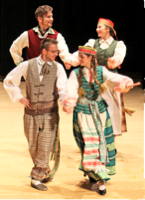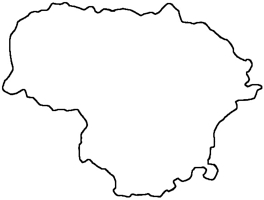
|
The Society of Folk Dance Historians (SFDH)
Lithuanian Folk Dances
[
Home |
About |
Encyclopedia | CLICK AN IMAGE TO ENLARGE |

|
 Lithuanian folk dances and Khorovods (choral dances) are distinguished for their symmetry: symmetry in the music, the movements, the pattern, and construction of the dances. Most of the steps are performed in pairs; first the dancers take a few steps forward, then the same number backwards; they move to the right and then to the left; they circle first in one direction, then the other. When the melody is repeated, the pattern of the dance also is repeated.
Lithuanian folk dances and Khorovods (choral dances) are distinguished for their symmetry: symmetry in the music, the movements, the pattern, and construction of the dances. Most of the steps are performed in pairs; first the dancers take a few steps forward, then the same number backwards; they move to the right and then to the left; they circle first in one direction, then the other. When the melody is repeated, the pattern of the dance also is repeated.
In most choreographies, the dancers are distributed symmetrically on the dance floor. There are an equal number of couples on each side, an equal number of dancers in the rows and rings, chains and columns. If there is a soloist dancing in the middle of the floor, the other dancers form a circle or semicircle. If the soloist dances on one side of the stage, the rest of the dancers move over to the other side.
Though there are a large number of varied movements in Lithuanian folk dance, most are executed with the feet, fewer with the hands, and very few with the head and body. The movements are light and gentle, not angular. Even in the faster dances, the turns are not sharp. Over thirty different steps are known, performed either singly or in combinations of two, three, or four different patterns that go to form a new step. The most frequently seen are the simple step, the running step, the side steep, the double and triple steps, and the polka step.
The number of steps in a dance is not usually very great; most often, a dance will have only one or two basic steps with or without variations, as well as several supplementary steps. Many dances have just one basic step. Because dance steps are traditional in character, it is not customary to mix them or bring the steps of one dance into another, lest the character and meaning of the dance be distorted.
Varied movements of the hands and arms are used to bring out the meaning of the dances, their character, and their national flavor. They are used, for example, to depict the growth of plants in one dance or the flight of birds in another. The hand movements are especially varied in dances and Khorovods that portray different work processes. In the Ruguchial (rye) dance, for example, the hands depict moving, sharpening the scythe, and binding sheaves, the way those processes were performed in the old days. Besides reflecting work processes, there are numerous Lithuanian dances portraying family life. Hand movements are different in almost every dance, depicting work or the motions of birds and animals.
Birds and animals are often enacted in Lithuanian folk dances. From living in such close contact with them, peasants have learned to portray their movement and habits to perfection. The young Lithuanian's best friend was his horse, and there are many folk songs about the horse. There also is a dance, the Jigunas (trotter), a fast, energetic, stimulating dance done by twelve men. It begins with six men imitating restless horses stamping the ground with their hooves. Then they race around in a circle and gallop. The dancers, each placing his hand on the shoulder of the man in front, form a row. The row advances and retreats repeatedly. Then six other men join in. During the dance the men form rows, then columns, then chains. When they dance together, they place their hands on another's shoulders, and when they dance alone, they fold their hands on their chests.
One of the oldest of Lithuanian folk dances, the Brezdingele, depicts the flight of swallows and expresses the hopes of the Lithuanian people for a happy future. It is done by an even number of girls, each of whom carries a kerchief. Holding onto the corners of the kerchiefs, the girls wave them high, while the last couple begins to swoop. Holding the corners of the kerchiefs, each couple swoops under an arch formed by the raised arms of another couple, then forms its own arch, and so on, first swooping, then forming an arch. The dance tempo increases and finally the girls form a "V" and wave their kerchiefs high in the air, representing the swallows flying south for the cold months.
In general, the Lithuanian people have no dances with the "pereplyas" (competition) found in Russian and Ukrainian folk dances. The nearest equivalent is the Ojlalis (little goat), a comic dance in which two groups and the individuals in them compete in skill and strength trying to outdo both their opponents and their partners in the leaps and also in the strength of the blows they deal their opponents. The dance begins with leaps in which the legs are spread or crossed. After testing their strength in that way, one group begins struggling with the other. The dancers "kick up their heels and butts." At the end, one of the dancers puts his arms about another dancer's neck and they whirl around, "kicking" each other with their feet.
Lithuanian folk dances have innumerable figures. Every dance has several characteristic figures that must remain, regardless of the overall choreography. These basic figures are part of the living folk dance. Developed and augmented by new figures, they make up the choreographic basis of professional Lithuanian folk dancing.
DOCUMENTS
- Baltic States, a region.
- Lithuania, a country.
- Traveling Russia and the Baltic States, an article.
- Vyts Beliajus, a teacher and author.
Adapted from an article on the Internet
by I. Lingis, Ballet Master,
Lithuanian State Folk Song and Dance
Printed in Folk Dance Scene, March 1997.
This page © 2018 by Ron Houston.
Please do not copy any part of this page without including this copyright notice.
Please do not copy small portions out of context.
Please do not copy large portions without permission from Ron Houston.